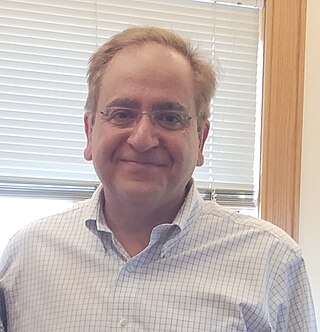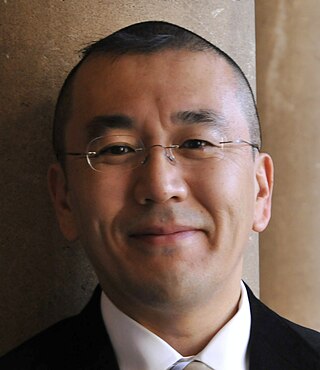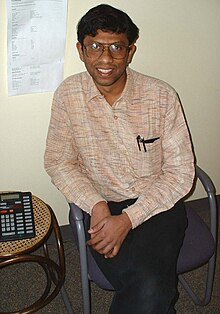
Ashoke Sen FRS is an Indian theoretical physicist and distinguished professor at the International Centre for Theoretical Sciences (ICTS), Bangalore. A former distinguished professor at the Harish-Chandra Research Institute, Allahabad, He is also an honorary fellow in National Institute of Science Education and Research (NISER) India he is also a Morningstar Visiting professor at MIT and a distinguished professor at the Korea Institute for Advanced Study. His main area of work is string theory. He was among the first recipients of the Breakthrough Prize in Fundamental Physics "for opening the path to the realization that all string theories are different limits of the same underlying theory".
In theoretical physics, F-theory is a branch of string theory developed by Iranian-American physicist Cumrun Vafa. The new vacua described by F-theory were discovered by Vafa and allowed string theorists to construct new realistic vacua — in the form of F-theory compactified on elliptically fibered Calabi–Yau four-folds. The letter "F" supposedly stands for "Father" in relation to "Mother"-theory.

Cumrun Vafa is an Iranian-American theoretical physicist and the Hollis Professor of Mathematics and Natural Philosophy at Harvard University.

Andrew Eben Strominger is an American theoretical physicist who is the director of Harvard's Center for the Fundamental Laws of Nature. He has made significant contributions to quantum gravity and string theory. These include his work on Calabi–Yau compactification and topology change in string theory, and on the stringy origin of black hole entropy. He is a senior fellow at the Society of Fellows, and is the Gwill E. York Professor of Physics.

Shiraz Naval Minwalla is an Indian theoretical physicist and string theorist. He is a faculty member in the Department of Theoretical Physics at Tata Institute of Fundamental Research, Mumbai. Prior to his present position, Minwalla was a Harvard Junior Fellow and subsequently an assistant professor at Harvard University.

Robertus Henricus "Robbert" Dijkgraaf, is a Dutch theoretical physicist, mathematician and string theorist, and the Minister of Education, Culture and Science in the Netherlands from 2022 until 2024. From July 2012 until his inauguration as a minister, he had been the director and Leon Levy professor at the Institute for Advanced Study in Princeton, New Jersey, and a tenured professor at the University of Amsterdam.
Shamit Kachru is an American theoretical physicist, a professor emeritus of physics at Stanford University, and a former Wells Family Director of the Stanford Institute for Theoretical Physics. He served as the Stanford Physics Department Chair from 2018 to 2021. He retired in 2023.
In theoretical physics, topological string theory is a version of string theory. Topological string theory appeared in papers by theoretical physicists, such as Edward Witten and Cumrun Vafa, by analogy with Witten's earlier idea of topological quantum field theory.
The Harish-Chandra Research Institute (HRI) is an institution dedicated to research in mathematics and theoretical physics, located in Prayagraj, Uttar Pradesh in India. Established in 1975, HRI offers masters and doctoral program in affiliation with the Homi Bhabha National Institute.
Sandip Trivedi is an Indian theoretical physicist working at Tata Institute for Fundamental Research (TIFR) at Mumbai, India, where had been the director. He is well known for his contributions to string theory, in particular finding the first models of accelerated expansion of the universe in low energy supersymmetric string. His research areas include string theory, cosmology and particle physics. He is now member of program advisory board of International Center for Theoretical Sciences (ICTS). He is also the recipient of the Infosys Prize 2010 in the category of Physical Sciences.
Spenta R. Wadia is an Indian theoretical physicist with research interests in elementary particle physics, quantum field theory and statistical physics, string theory and quantum gravity. His other scientific interests are in complex systems including cross-disciplinary biology. He is a recipient of the 2004 TWAS Prize in Physics; the 1995 Physics Prize of the International Centre for Theoretical Physics (ICTP); and the J. C. Bose Fellowship of the Govt of India. He is an elected member of TWAS, and a Fellow of all the Science Academies of India. In 2024, he was elected to the American Academy of Arts and Sciences, one of the United States' oldest and most prestigious scholarly societies.

Hirosi Ooguri is a theoretical physicist working on quantum field theory, quantum gravity, superstring theory, and their interfaces with mathematics. He is Fred Kavli Professor of Theoretical Physics and Mathematics and the Founding Director of the Walter Burke Institute for Theoretical Physics at California Institute of Technology. He is also the director of the Kavli Institute for the Physics and Mathematics at the University of Tokyo and is the chair of the board of trustees of the Aspen Center for Physics in Colorado.
Trivandrum Ramakrishnan "T. R." Ramadas is an Indian mathematician who specializes in algebraic and differential geometry, and mathematical physics. He was awarded the Shanti Swarup Bhatnagar Prize for Science and Technology in 1998, the highest science award in India, in the mathematical sciences category.
Gary T. Horowitz is an American theoretical physicist who works on string theory and quantum gravity.
In theoretical physics, Rajesh Gopakumar and Cumrun Vafa introduced in a series of papers new topological invariants, called Gopakumar–Vafa invariants, that represent the number of BPS states on a Calabi–Yau 3-fold. They lead to the following generating function for the Gromov–Witten invariants on a Calabi–Yau 3-fold M:

Mina Aganagić is a mathematical physicist who works as a professor in the Center for Theoretical Physics, the Department of Mathematics, the Department of Physics at the University of California, Berkeley.
Amalendu Krishna is an Indian mathematician in the Department of Mathematics, University of California at Santa Barbara (UCSB), Santa Barbara, specializing in algebraic cycles and K-theory. He was awarded the Shanti Swarup Bhatnagar Prize for Science and Technology, India's highest prize for excellence in science, mathematics and technology, in the mathematical sciences category in the year 2016.

Atish Dabholkar is an Indian theoretical physicist. He is currently the Director of the Abdus Salam International Centre for Theoretical Physics (ICTP) with the rank of Assistant Director-General, UNESCO. Prior to that, he was head of ICTP's High Energy, Cosmology and Astroparticle Physics section, and also Directeur de Recherche at the Centre National de la Recherche Scientifique (CNRS) at Sorbonne University in the "Laboratoire de Physique Théorique et Hautes Énergies" (LPTHE).

Aditi Sen De is an Indian scientist, a professor in quantum information and computation group at the Harish-Chandra Research Institute, Prayagraj. She was born on 1 October 1974 in Kolkata, India. She is known for her research on quantum information and computation, quantum communication including quantum cryptography, quantum optics and many-body physics. The Council of Scientific and Industrial Research, the apex agency of the Government of India for scientific research, awarded her the Shanti Swarup Bhatnagar Prize for Science and Technology for her contributions to physical sciences in 2018. She is the first female physicist to be given this honour. In 2022, she was elected as a member of Indian Academy of Sciences and Indian National Science Academy.
Matthias Gaberdiel is a theoretical physicist and full professor at ETH Zurich. He is known for his work on higher-spin theory and conformal field theory.









